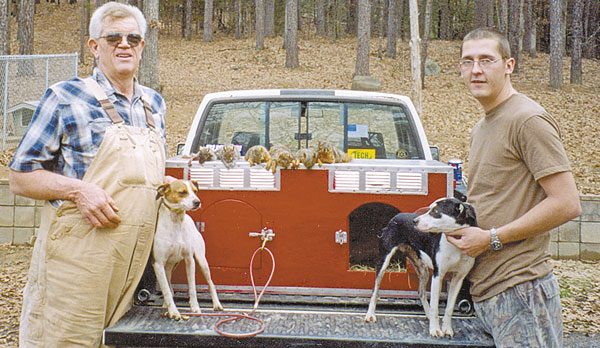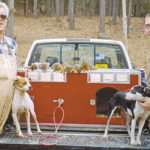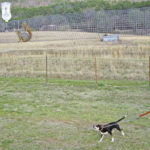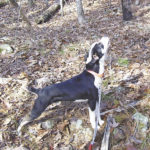
A dog makes a big difference for squirrel hunters.
Squirrels can be hunted on foot with no help other than sharp eyes and a quiet approach, but bringing a dog into the equation can make a hunt more exciting — and a lot more successful, too. “It’s by far the most productive way to hunt squirrels,” said veteran hunter Kurt Hinchman of Black Jack. “A hunter can’t just take any old dog out to the Game Lands, turn it loose and expect it to tree a squirrel for him. It does take some training, and it also takes a certain type of dog.”
A well-trained squirrel dog makes the hunt a much simpler procedure. Hunters can walk without worrying about noise and enjoy being outside — while the dog is finding shadowtails.
Hinchman said a squirrel dog will be a particularly good hunting dog if it hunts primarily by using its sense of smell. This may seem elementary and may seem to be a given for dogs, but some dogs hunt primarily by sight. They’ll seek squirrels only by looking for when the quarry makes a move or begins to run on the ground or in the tree tops.
Hunting only by sight, a dog can miss squirrels, and dogs who key on movements also are more likely to loose track of squirrels.
Breeds used for squirrel hunting are chosen because of their speed, agility, size and persistent, inquisitive nature.
According to Larry Renfroe, an avid hunter from Pottsville, Ark., who breeds squirrel dogs, the best breeds are hounds — blueticks and redbones in particular — and “mountain” curs. Jack Russell terriers and rat terriers (feists) also can be pretty good squirrel dogs.
Breeding squirrel dogs and training them to be great hunters is a family tradition for Renfroe. He breeds dogs specifically for traits that mean they’ll become efficient squirrel hunters. He sells dogs as puppies, at different levels of training, and even accepts adult dogs, which he spends a few months training to hunt squirrels.
But finding a good squirrel dog isn’t as simple as choosing any dog from one of the preferred, although mixed breeds also can be good hunting dogs. Hinchman said he believes great squirrel dogs are born and not made.
“Not many dogs have (the ability to hunt squirrels), and you can’t tell just by looking at him,” he said. “You have to get one from a good stock, knowing its mom and dad came from a treeing stock.”
Even then, he said, purchasing a squirrel dog that knows what to do isn’t a sure thing.
“It’s what’s between its ears that matters,” Hinchman said.
Hinchman focuses on one dog at a time when hunting, and he focuses on communicating with that dog during the hunt. He and his dogs have developed an understanding of one another’s signs and signals to become an efficient hunting team.
Successful squirrel dogs hunt silently until they find a squirrel, and although they roam the forest, they’re mindful of their owner’s location and will stay relatively close to him, knowing when they begin to bark at a treed squirrel, their owner will arrive quickly.
Hinchman’s dog will only travel about 100 yards away while searching for squirrels. If no squirrels are in an area, the dog will return and wait for Hinchman to walk farther into the woods before starting to hunt again.
Once a good dog either scents or sees a squirrel and chases it up a tree, it either puts its front legs up on the base of tree the squirrel is in or stands a few paces back from the tree and barks continually to signal its owner.
“If the dog’s barking with a higher (pitch) ‘yip,’ he’s looking right at (the squirrel),” Hinchman said.
If the dog knows the squirrel is in a tree but can’t see it, the bark will be at a lower pitch.
If a hunter has the luxury of starting early in a dog’s training, the canine has a greater chance of being a good squirrel dog.
“Teaching them basic commands — sit, speak, fetch — is important,” Renfroe said. “You want to do that when the pup’s about eight weeks old.”
Curs and hounds generally are known for having great senses of sight and smell. While they’re still pups, one of the areas that Renfroe recommends focusing on is the dog’s sense of smell. If a dog focuses on its sense of smell, he’ll use that sense during a hunt — which will really pay off.
“I hide treats in places around the yard and then turn him loose,” Renfroe said. “I make a game of it.”
The dog will learn to scout the area, determined to find the treats.
Renfroe said it’s important to limit sessions to short periods of time, because sessions that are too long can be counterproductive. Five-minute sessions, three times per week, is all that’s needed.
Renfroe also uses a teaching exercise that involves a live squirrel and a mesh pipe. He builds a tube out of mesh wire about 18 inches in diameter and about 30 feet long.
He traps a squirrel and puts the animal inside the tube. For 10-minute sessions, three times per week, he puts a leash on a dog, holds the leash and allows the dog to run underneath the squirrel, chasing it back and forth.
As the dog is running, Renfroe gives voice commands such as “look up.”
This training regimen conditions the dog so it’s not always searching on the ground, so when it chases a squirrel up a tree, it will know to follow the squirrel up the tree with its eyes.
It’s important the tube be suspended an adequate distance off the ground so the dog isn’t tempted to leap up at the squirrel. Squirrel dogs shouldn’t be jumpers, so hunters need to teach the animal to point up at the tree base and bark to signal it has treed a squirrel.
Hinchman’s method for conditioning his dog to keep its eyes up is done during the hunt. While his dog is young, Hinchman will hunt with a .22 rifle loaded with hollow-point short bullets.
Because “shorts” are low-velocity loads, they don’t make a loud “crack” when fired. Since the bullets are hollow point, the “pop” of the bullet hitting the squirrel will cause the dog to look up.
Hinchman said all it takes is three of four repetitions — that include bagging a squirrel — and a dog will learn when a squirrel runs up a tree, its attention should be focused upward.
When he’s hunting, Renfroe carries a plastic bag filled with pieces of hot dogs to reward his dogs for good deeds.
The worst thing a hunter can do while training his dog is to shake a vine (or intentionally scare a squirrel out for the dog to chase), Hinchman said.
“That’ll spoil him,” he said. “He’ll be waiting for you every time, instead of finding (squirrels) himself.”
But once a dog is properly trained, he’s a hunter for life.






Be the first to comment